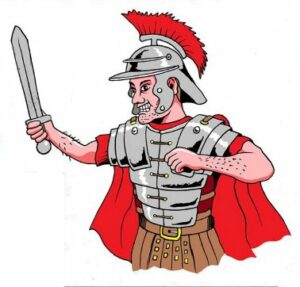
Did you know that:
- The Romans had built a road network of 53,000 miles by the early fourth century.
- Each Roman mile was about 4,800 feet and marked by a milestone, giving birth to the saying “All roads lead to Rome.”
- In Ancient Rome, only free-born men were allowed to wear togas, a sign of Roman citizenship. Women wore stolas, the female version of togas, made from linen.
- Women in ancient Rome dyed their hair with goat fat and beech wood ashes. The most popular colors were red and blond.
- The first ever shopping mall was built in Rome between 107 and 110 AD by Emperor Trajan. It sold a wide variety of goods and grocery items.
The Colosseum
It was completed in the year AD 80 and could seat approximately 50,000 spectators. The monument was built with the purpose of hosting the combat between gladiators and battles with animals.
The Army
 The Romans built such a huge empire and conquered new lands, thanks to their strong army. The Roman army could march up to 40km a day!
The Romans built such a huge empire and conquered new lands, thanks to their strong army. The Roman army could march up to 40km a day!
During battle, a Roman soldier or ‘legionary’ first hurled his spear at the enemy, then he fought him with his sword. To protect himself, he carried a wooden shield and wore a metal helmet and armour.
Aqueducts
To bring water to their cities, the clever Romans built aqueducts – a system of channels and bridges – to transport water for public baths and toilets!
Roman Food
The Romans liked to enjoy their food, often lying down on a couch while eating with their hands. They occasionally used a spoon, but they would never use a knife and fork. Rich Romans liked to eat exotic food, such as stork, roast parrot and even flamingo
Colosseum
One of the most famous buildings left by the Ancient Romans is the Colosseum – a huge ampitheatre in the centre of Rome. This is where members of the public would come to watch sporting events and games, including battles between Roman gladiators!
Tunics
Two pieces of woollen fabric sewn together at the sides and shoulders, with openings for your arms and head – were the most common clothes in Rome. Some Romans also wore togas – a kind of woollen shawl – to show how wealthy they were.
Isn’t history fun?
10 questions to discuss:
- How did the vast Roman road network influence trade, communication, and military expansion?
- Why were togas reserved for free-born men? What did other clothing choices signify in Roman society?
- What health risks or practical challenges might hair dye made from goat fat and beech wood ashes have posed?
- What factors led to the development of the first shopping mall in Rome? How did it compare to modern shopping experiences?
- Besides public entertainment, did the Colosseum serve any other political or social functions?
- Was the Roman army’s remarkable marching ability due solely to physical fitness or were there any unique training methods or technologies involved?
- How did the aqueduct system impact sanitation and public health in Roman cities?
- Were there any ethical or environmental concerns surrounding the consumption of exotic foods by wealthy Romans?
- How did social class and gender roles influence dietary habits and mealtime customs in Ancient Rome?
- Beyond the Colosseum, what other architectural and engineering feats of the Romans showcase their advanced technology and resourcefulness?
These questions are to encourage deeper exploration of various aspects of Roman life mentioned in the blog, prompting further research and critical thinking.
For more information on this:
http://www.primaryhomeworkhelp.co.uk/romans/soldiers.html
https://www.thecollector.com/how-did-romans-build-aqueducts/
https://www.pbs.org/empires/romans/empire/women.html
© Tony Dalton

